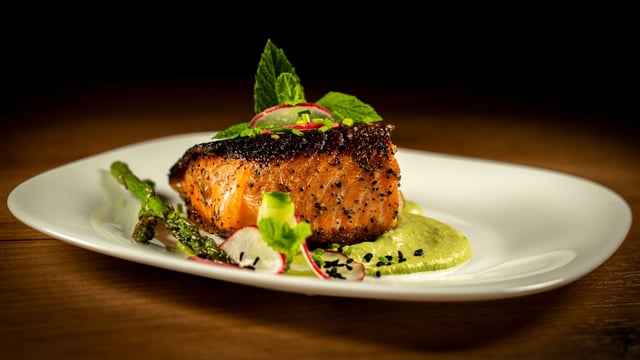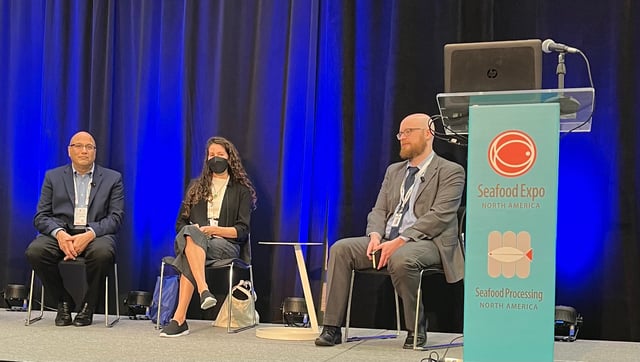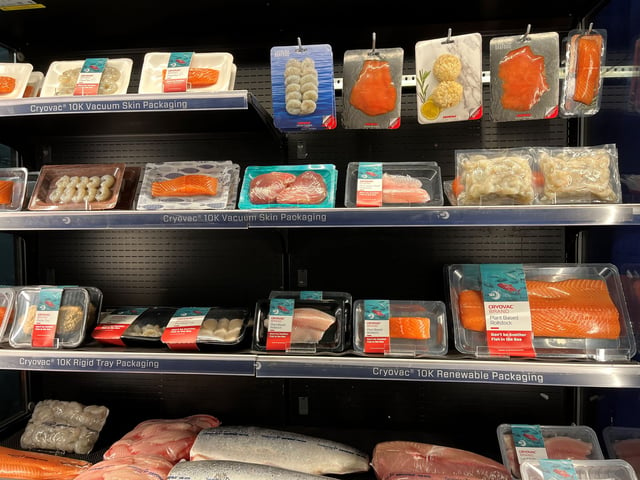What's Next in Seafood Sustainability?
Sustainability has been a major trend for some years now in seafood, but where is it going next? A visit to Seafood Expo North America, which took place March 13-15 in Boston in person for the first time since 2019, revealed a range of initiatives undertaken by stakeholders to further sustainability in seafood.
Package Deals
Packaging maker Sealed Air displayed some of its sustainable packaging solutions, including plant-based renewable roll stock, partly made from cornstarch instead of oil-based plastics, and the company’s Darfresh vacuum skin packaging mounted on recyclable cardboard. Scott Corey, director of marketing, seafood and adjacent markets at Charlotte, N.C.-based Sealed Air, acknowledged the increasing demand for sustainable packaging materials as retailers and manufacturers seek to lower their greenhouse-gas emissions, and noted that the use of cardboard was a European trend now gaining steam in the United States.
Culture Shift
A March 13 panel discussion at the expo on cell-cultured seafood, featuring Lou Cooperhouse, president and CEO of San Diego-based BlueNalu, and Marika Azoff, corporate engagement seafood specialist at The Good Food Institute, in Washington, D.C., and moderated by Chris Chase, editor at Portland, Maine-based SeafoodSource, noted that a key advantage of the product was that it supported sustainability by being better for the environment. As Cooperhouse pointed out, governmental interest in cell-cultured seafood is driven by the issue of food security as global warming contributes to ocean depletion. He predicted that by 2030, large-scale production of this type of seafood — created by a process he likened to the brewing of beer — at big factories was likely.
Bycatch Begone
Also during the show, Honolulu-based Sustainable Fisheries Partnership (SFP) launched a new online interactive tool that provides a visual evaluation of methods to reduce wildlife bycatch in tuna longline fisheries, based on those methods’ relevance to specific species, effectiveness, ease of implementation, and cost.
“Sustainable seafood means reducing the harm from fishing to sharks, marine mammals, sea turtles and seabirds,” said Kathryn Novak, global markets director at SFP, on the occasion of the Solve My Bycatch Problem launch, which took place at the marine conservation organization’s Bycatch Solutions Open House on March 14. “Action by retailers and the entire seafood supply chain is essential to reducing bycatch of ocean wildlife.”
The open house enabled retailers and seafood suppliers in attendance to connect with experts on the latest bycatch reduction technologies and initiatives.
In the course of a chat with Progressive Grocer ahead of the launch, Novak observed that the new program highlighted proven best practices at fisheries to effect change, spur adoption at scale, and drive innovation and further improvement in this area. She explained that over the past year and a half, the emphasis had shifted from conservation to “restoration of balance to the ecosystem.” She also noted that seafood sales had risen dramatically during the pandemic as more consumers began preparing and eating food at home, and that initiatives of this kind, capitalizing on rising consumer interest in sustainability, were a way to retain those sales. As far as retailers’ promotional efforts in this regard, Novak was hopeful that that there “will be good stories to tell,” just as there have been with retailers involved in SFP’s popular Ocean Disclosure Project, a reporting framework introduced in 2015 for seafood companies, including retailers and suppliers, to voluntarily disclose their wild-caught seafood sourcing alongside information on the environmental performance of each source.
Grass-Roots Effort
As it prepares to boost its U.S. presence, the Utrecht, Netherlands-based Aquaculture Stewardship Council (ASC) is beefing its up its tech investment, which will allow the organization to offer such resources as trace element fingerprinting that will be able to verify ASC-certified seafood back to its farm of origin with better than 95% accuracy, and digital tagging and tracing through every stage of the supply chain, from farm to point of sale, along with chain-of-custody protocols that each member of the seafood supply chain must follow to prevent fraud and promote secure handling. Speaking to PG on the Seafood Expo floor, ASC USA Director of Marketing Mark Lang described the forthcoming tech offerings, which should become available over the next two years, as enhancements to the organization’s existing certification program.
ASC’s planned media program promoting these enhancements consists of coordinated targeted social and digital communication, along with a “boots-on-the-ground” presence in three U.S. cities at a time, starting in Miami, Minneapolis and Philadelphia, where the organization will team with local retailers and restaurants on sampling and show-and-tell events, with the eventual goal of spreading nationwide. Additionally, in a genius move, the five-year marketing strategy includes establishing a presence at universities through partnerships with cafeteria chefs. Currently, 22 universities will feature ASC-certified salmon on the menu, targeting the very demographic — Gen Z — that likely would be most interested in the organization’s sustainability story.
According to Lang, the idea behind aquaculture is to help achieve “sustainability at a global level” by providing farmed seafood to meet world demand, given the decreasing supply of wild-caught product. “There’s great potential in the big picture” for aquaculture, he said, “but it has to be done right.”
Maine Events
Speaking of aquaculture done right, the Maine Aquaculture Association has had that goal since it was founded back in 1977, making it the oldest state aquaculture organization in the country. According to Executive Director Sebastian Belle, with whom PG spoke during the expo, the Hallowell-based nonprofit association also pioneered the internal adoption of best practices, developing codes of conduct to which farmers were expected to adhere, with external audits and third-party certification beginning in 1991. Today, the Maine Aquaculture Association spends much of its time providing support services, including business planning, to new farmers. Belle pointed out that Maine’s aquaculture community is an increasingly diverse group whose average age is in the mid-thirties.
In regard to sustainability specifically, Belle admitted that it was difficult to get farmers to change their behavior, and that a top-down approach didn’t work. “It has to come from the farmers themselves,” with the right incentives, he noted.
Getting the Message Across
Food retailers and other seafood industry stakeholders that want to encourage further seafood consumption while promoting sustainability need look no further than the More if By Sea messaging platform created by Philadelphia-based food strategy consultancy Changing Tastes. The platform, which was presented at the expo on March 15, aims to shift American appetites more heavily toward foods from the ocean by enhancing the effectiveness of the messages and advice that users share with customers, partners and the public.
“We are at a demographic fork in the road where changing the messages we use can both substantially increase the market for fish and seafood and also help maintain current demand,” explained Changing Tastes Managing Director Arlin Wasserman. “The increase in fish and seafood consumption over the past decade has been driven by the Baby Boomer generation, which has embraced a message of seafood as simple and healthy, including a focus on healthy fats and heart health. But America is experiencing a generational shift, with Millennials now being the largest demographic group. Today’s consumers increasingly see their own health and the health of the oceans connected through eating fish and seafood. To increase consumption, we need to adopt new messages and approaches that match the preferences, attitudes and beliefs of those poised to eat more fish and seafood. This new messaging platform is designed to do just that.”












